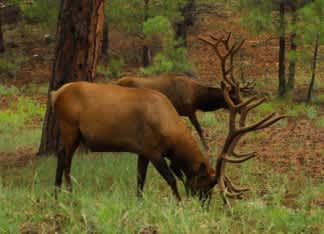Challenging Elk Hunts Offered for Fall Hunting Season near Flagstaff, Arizona
Arizona Game and Fish Department 01.25.13

Hunters that are looking for a physically challenging hunt in an area with limited vehicular access should consider applying for tags for the “Peaks Hunt Area” in Game Management Unit 7 East, just north of Flagstaff.
For the second year in a row, the Arizona Game and Fish Commission has approved any-elk and antlerless elk tags in the Peaks Hunt Area in Unit 7 East to promote successful aspen regeneration. Approximately 90 percent of all aspen found on the Coconino National Forest are found in this limited hunt area. Recent wildfires have killed some of the adult aspen trees, but have also stimulated extensive sprouting of young aspen that elk prefer to eat especially during the fall. Wildlife biologists believe that by focusing elk management in this area now, chances will increase for robust aspen regeneration.
“We are offering these permits in coordination with the Coconino National Forest as another habitat management tool for aspen regeneration on the Peaks,” says Carl Lutch, wildlife program manager for the Flagstaff regional office. “There are other factors impacting aspen trees, but reducing the number of elk that utilize aspen is one piece of the puzzle in helping aspen recover on the Coconino National Forest.”
For more than a decade, wildlife biologists and land managers have been working to keep aspen stands healthy on the San Francisco Peaks. The U.S. Forest Service has invested more than $600,000 in recent years to promote aspen regeneration in the area through a variety ofmethods. Monitoring indicates that without intervention many of the aspen in the area could be lost. In addition to browsing by wildlife and livestock, some of the factors that affect aspen health include lack of fire, disease, drought, insects, late frosts, and crowding by other species of trees like conifers. While aspen are short-lived trees that are susceptible to many disturbances, their natural defense is to sprout vigorously from the roots when adult trees die. If sprouts are killed several years in a row, the root system and the trees will eventually die.
Game and Fish and the Forest Service want hunters who put in for this area to know that the hunts are primarily wilderness hunts that are more physically challenging than other hunt areas. These hunts are tailor-made for hunters who want to get away from roads and hunt on foot or horseback. An added benefit to hunters is that the Peaks Hunts are offered at a time of year when elk are rutting and the aspen are in full fall splendor. The unit includes both the San Francisco Peaks and the very scenic Hart Prairie.
The Flagstaff Ranger District on the Coconino National Forest is anxious to help motivated hunters who choose this hunt unit. Limited areas of the unit are closed to horseback access to protect Flagstaff’s water supply in the inner basin. Special regulations also apply in the Kachina Peaks wilderness, but with advance planning this unit provides outstanding opportunities to hunt elk in a remote setting. The Forest Service will have a special link on their website that will provide Peaks Unit hunters with updated information and tips on access into prime hunting locations.
“This hunt unit offers the type of setting you would normally expect somewhere like Colorado or Montana, so the tactics need to be a little different,” says U.S. Forest Service District Ranger Mike Elson. “In addition to providing a unique experience in Arizona, this hunt is also a critical tool in helping us manage for healthy aspen and healthy elk habitat.”
The 2013 Pronghorn and Elk hunt regulation booklet is available now. The deadline to apply for hunts is by 7p.m. on Tuesday, Feb.12.

